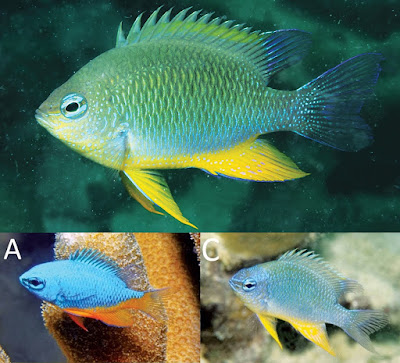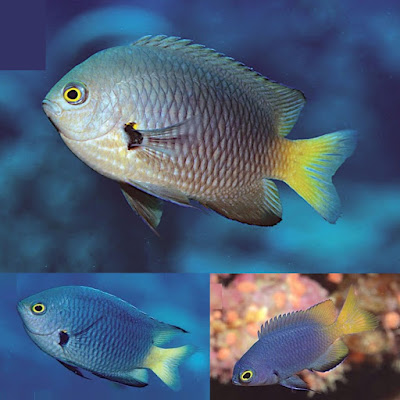 |
| Chrysiptera burtjonesi Allen, Erdmann & Cahyani, 2017 Journal of the Ocean Science Foundation. 28 |
Abstract
A sixth member of the Chrysiptera oxycephala group of Pomacentridae, Chrysiptera burtjonesi n. sp., is described on the basis of 24 specimens, 20.5–48.2 mm SL, collected at the Solomon Islands in the western Pacific Ocean. It differs from other members of the group, including C. ellenae (Raja Ampat Islands, West Papua Province in Indonesia), C. maurinae (Cenderawasih Bay, West Papua Province), C. oxycephala (central Indonesia, Philippines, and Palau), C. papuensis (northeastern Papua New Guinea), and C. sinclairi (Bismarck Archipelago and islands off northeastern Papua New Guinea), on the basis of its distinctive color pattern and a 6.9% divergence in the sequence of the mitochondrial control region from its closest relative (C. maurineae). Adults are primarily grayish brown to greenish except bright yellow on the ventralmost head and body, including the adjacent pelvic and anal fins. Juveniles are mostly neon blue to dark blue with bright yellow pelvic and anal fins. In addition, it is the only species besides C. sinclairi that usually lacks embedded scales on the preorbital and suborbital bones.
Chrysiptera burtjonesi, n. sp.
Burt’s Damselfish
Diagnosis. A species of the pomacentrid genus Chrysiptera with the following combination of characters: dorsal-fin rays XIII,11 (rarely 10 or 12); anal-fin rays II,12 (rarely 13); pectoral-fin rays 15 (14–16); gill rakers on first branchial arch 9–11+20–22, total gill rakers 29–32; tubed lateral-line scales 13–16 (usually 14–15); preorbital+suborbital scales usually absent, occasionally 1–3 embedded scales present; color of adult overall grayish brown to greenish (sometimes with neon blue/green transverse streak on each scale) with translucent to pale greenish fins, except bright yellow ventrally on head, body, and adjacent anal and pelvic fins, a broad yellow band from base of first few dorsal-fin spines to outer edge of last dorsal-fin spine; juvenile neon blue on head, most of body (above diagonal line from pelvic-fin base to base of uppermost caudal-fin ray), and dorsal fin, remainder of body and adjacent fins bright yellow.
Etymology. This species is named in honor of photographer and underwater guide par excellence Burt Jones of Sequim, Washington, USA. Burt and his partner Maurine Shimlock were pioneers for the promotion of dive tourism at the Solomon Islands and, more recently, have been instrumental in the tremendous popularity of the West Papuan region by means of their excellent underwater guidebook to the area and creation of the highly informative Bird’s Head Seascape website (birdsheadseascape.com).
Distribution. The new species is known only from the Solomon Islands. It was collected or observed by the authors at the following islands and reefs: Isabel, Choiseul, Makira, Malaita and nearby Alite Reef, Shortland Islands, New Georgia Group, Russell Group, and the Florida Group.
Burt’s Damselfish
Diagnosis. A species of the pomacentrid genus Chrysiptera with the following combination of characters: dorsal-fin rays XIII,11 (rarely 10 or 12); anal-fin rays II,12 (rarely 13); pectoral-fin rays 15 (14–16); gill rakers on first branchial arch 9–11+20–22, total gill rakers 29–32; tubed lateral-line scales 13–16 (usually 14–15); preorbital+suborbital scales usually absent, occasionally 1–3 embedded scales present; color of adult overall grayish brown to greenish (sometimes with neon blue/green transverse streak on each scale) with translucent to pale greenish fins, except bright yellow ventrally on head, body, and adjacent anal and pelvic fins, a broad yellow band from base of first few dorsal-fin spines to outer edge of last dorsal-fin spine; juvenile neon blue on head, most of body (above diagonal line from pelvic-fin base to base of uppermost caudal-fin ray), and dorsal fin, remainder of body and adjacent fins bright yellow.
Etymology. This species is named in honor of photographer and underwater guide par excellence Burt Jones of Sequim, Washington, USA. Burt and his partner Maurine Shimlock were pioneers for the promotion of dive tourism at the Solomon Islands and, more recently, have been instrumental in the tremendous popularity of the West Papuan region by means of their excellent underwater guidebook to the area and creation of the highly informative Bird’s Head Seascape website (birdsheadseascape.com).
Distribution. The new species is known only from the Solomon Islands. It was collected or observed by the authors at the following islands and reefs: Isabel, Choiseul, Makira, Malaita and nearby Alite Reef, Shortland Islands, New Georgia Group, Russell Group, and the Florida Group.
Gerald R. Allen, Mark V. Erdmann and N.K. Dita Cahyani. 2017. A New Species of Damselfish (Chrysiptera: Pomacentridae) from Coral Reefs of the Solomon Islands. Journal of the Ocean Science Foundation. 28; 10–21.
http://www.oceansciencefoundation.org/josf/josf28b.pdf
http://www.oceansciencefoundation.org/josf/josf28b.pdf
---------------------------------------------------------------
روابط التحميل والمشاهدة، الروابط المباشرة للتحميل
او
شاهد هذا الفيديو القصير لطريقة التحميل البسيطة
كيف تحصل على مدونة جاهزة بآلاف المواضيع والمشاركات من هنا
شاهد قناة منتدى مدونات بلوجر جاهزة بألاف المواضيع والمشاركات على اليوتيوب لمزيد من الشرح من هنا
رابط مدونة منتدى مدونات بلوجر جاهزة بآلاف المواضيع والمشاركات في أي وقت حــــتى لو تم حذفها من هنا
شاهد صفحة منتدى مدونات بلوجر جاهزة بألاف المواضيع والمشاركات على الفيس بوك لمزيد من الشرح من هنا
شاهد صفحة منتدى مدونات بلوجر جاهزة بألاف المواضيع والمشاركات على الفيس بوك لمزيد من الشرح من هنا
تعرف على ترتيب مواضيع منتدى مدونات بلوجر جاهزة بآلاف المواضيع والمشاركات (حتى لا تختلط عليك الامور) من هنا
ملاحظة هامة: كل عمليات تنزيل، رفع، وتعديل المواضيع الجاهزة تتم بطريقة آلية، ونعتذر عن اي موضوع مخالف او مخل بالحياء مرفوع بالمدونات الجاهزة بآلاف المواضيع والمشاركات، ولكم ان تقوموا بحذف هذه المواضيع والمشاركات والطريقة بسيطة وسهلة. ــــــــــــــــــــــــــــــــــــــــــــــــــــــــــــــــــــــــــــــسلامـ.


















